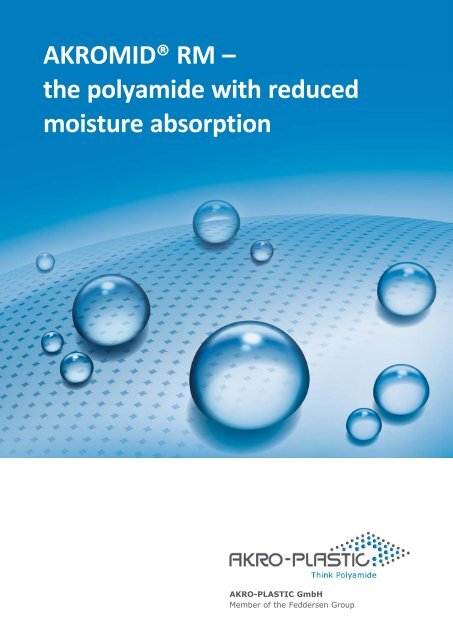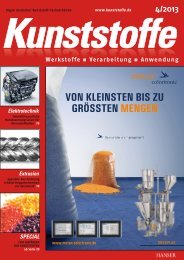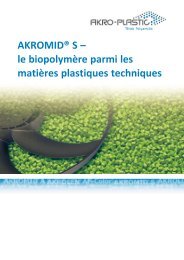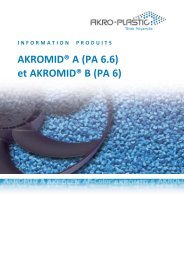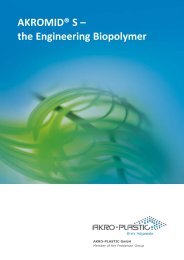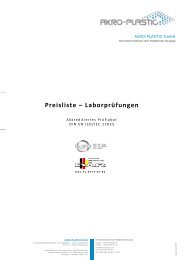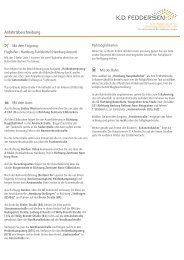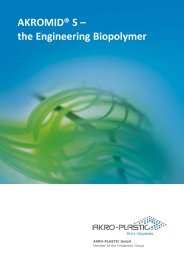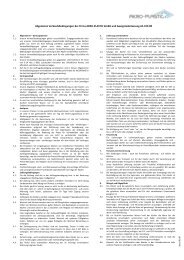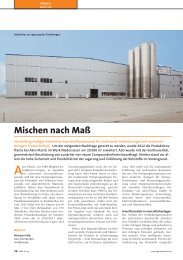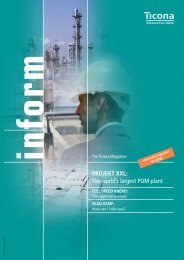AKROMID® RM brochure A3 - AKRO-PLASTIC GmbH
AKROMID® RM brochure A3 - AKRO-PLASTIC GmbH
AKROMID® RM brochure A3 - AKRO-PLASTIC GmbH
- No tags were found...
You also want an ePaper? Increase the reach of your titles
YUMPU automatically turns print PDFs into web optimized ePapers that Google loves.
<strong>AKRO</strong>MID® <strong>RM</strong> –the polyamide with reducedmoisture absorption<strong>AKRO</strong>-<strong>PLASTIC</strong> <strong>GmbH</strong>Member of the Feddersen Group
Polyamides are materials which havean extremely balanced profile ofproperties and can therefore beused in many industries to producea wide range of components.However, polyamides absorb water(e.g. humidity). This absorption resultsin increased flexibility andtoughness and reduced stiffness,strength and hardness. Resultantchanges in volume (swelling) canlead to warpage of the component.With <strong>AKRO</strong>MID® <strong>RM</strong> (ReducedMoisture), <strong>AKRO</strong>-<strong>PLASTIC</strong> <strong>GmbH</strong> hassuccessfully met the challenge ofdeveloping a polyamide which exhibitsthe typical, positive propertiesof PA6 yet has lower water/moistureabsorption rates. <strong>AKRO</strong>MID® <strong>RM</strong>is available in two product lines:<strong>AKRO</strong>MID® <strong>RM</strong>-M (mechanicalgrades) and <strong>AKRO</strong>MID® <strong>RM</strong>-D (designgrades).With a reduction in water absorptionof up to 50 % compared withstandard PA6, the residual stiffnessand strength of the componentsafter conditioning is greater thanwith standard PA6. Weight-saving istherefore possible.In the overview (right) and on thefollowing pages, the technical dataand possibilities are displayed for awhole variety of technically innovativeapplications with greater dimensionalstability.
<strong>AKRO</strong>MID® <strong>RM</strong>-M mechanical series (PA 6)Typical values for black colourmaterial at 23° CTest Specification Test Method UnitB3 GF 15 <strong>RM</strong>-M(3696)B3 GF 30 <strong>RM</strong>-M(3016)B3 GF 50 <strong>RM</strong>-M(3146)B3 GF 15 9 <strong>RM</strong>-M(3512)B3 GF 30 9 <strong>RM</strong>-M(30 99)B3 GF 50 9 <strong>RM</strong>-M(3147)B3 GF 15 4 <strong>RM</strong>-M(3440)B3 GF 30 4 <strong>RM</strong>-M(3476)B3 GF 50 4 <strong>RM</strong>-M(3221)Mechanical Properties d.a.m. cond. d.a.m. cond. d.a.m. cond. d.a.m. cond. d.a.m. cond. d.a.m. cond. d.a.m. cond. d.a.m. cond. d.a.m. cond.Tensile modulus 1 mm/min ISO 527-1/2 MPa 6,200 4,200 11,000 7,100 17,000 12,000 6,200 4,200 10,500 7,500 16,000 13,000 6,300 4,300 9,500 7,500 16,500 13,000Yield stress²/Tensile stress at break 5 mm/min ISO 527-1/2 MPa 125 85 165 110 210 135 125 85 170 115 210 145 130 87 170 115 210 160Elongation at break 5 mm/min ISO 527-1/2 % 3 4.5 2.6 4.5 2.2 3 3 4.5 2.6 4.2 2.2 3 3 4.5 2.8 4.2 2 2.7Flexural modulus 2 mm/min ISO 178 MPa 4,800 9,600 17,500 4,800 9,600 17,200 4,800 9,500 16,800Flexural stress³ 2 mm/min ISO 178 MPa 190 250 320 190 250 330 190 250 320Charpy impact strength 23 °C ISO 179-1/1eU kJ/m² 45 50 70 70 70 70 45 50 70 70 70 70 42 50 75 70 75 75Charpy impact strength -30 °C ISO 179-1/1eU kJ/m² 40 40 65 60 60 60 40 40 65 60 60 60 40 40 65 60 60 60Charpy notched impact strength 23 °C ISO 179-1/1eA kJ/m² 7 8 12 15 20 20 7 8 12 13 20 20 7 8 12 13 20 20Charpy notched impact strength -30 °C ISO 179-1/1eA kJ/m² 7 7 10 10 15 20 7 7 10 10 16 20 7 7 10 10 16 20Ball indentation hardness HB 961/30 ISO 2039-1 MPa 180 230 280 180 230 280 180 230 280Electrical Properties d.a.m. d.a.m. d.a.m. d.a.m. d.a.m. d.a.m. d.a.m. d.a.m. d.a.m. d.a.m.Comparative tracking index,CTITest solution A IEC 60112 600 600 600 600 600 600 600 600 600 600Thermal PropertiesMelting point DSC, 10 K/min ISO 11357-1 °C 225 225 225 225 225 225 225 225 225 225Heat distortion temperature, HDT/A 1.8 MPa ISO 75-1/2 °C 200 210 215 195 205 205 210 195 200 205Heat distortion temperature, HDT/C 8 MPa ISO 75-1/2 °C 160 165 160 160 165 160 165FlammabilityFlammability acc.UL 94 0.8 mm UL 94 Class HB HB HB HB HB HB HB HB HB HBRate acc. FMVSS 302(< 100 mm/min)General Properties> 1 mmthicknessFMVSS 302 mm/min + + + + + + + + + +Density 23 °C ISO 1183 g/cm³ 1.28 1.41 1.62 1.28 1.41 1.41 1.61 1.28 1.41 1,6Content reinforcement ISO 1172 % 15 30 50 15 30 30 50 15 30 50Moisture absorption 70 °C/62 % r.h. ISO 1110 % 2.2 1.65 1.2 2.1 1.6 1.6 1.2 2.1 1.6 1,2ProcessingFlowability Flowspiral¹ <strong>AKRO</strong> mm 880 700 500 830 700 700 500 820 670 500Processing shrinkage,flowProcessing shrinkage,transverseISO 294-4 % 0.5 0.3 0.4 0.5 0.4 0.4 0.4 0.4 0.25 0.3ISO 294-4 % 0.9 0.8 0.7 0.8 1.0 1.0 0.7 0.7 0.7 0.7¹ = mould temperature: 80 °C, melt temperature: 270 °Cinjection pressure: 750 bar, cross section of flow spiral: 7 mm x 3,5 mm² = yield stress and elongation at break: test speed 50 mm/min³ = unreinforced compounds at flexural strain of 3.5 %+ = passed“cond.” test values = conditioned, measured on test specimens stored according to ISO 1110“d.a.m.” = dry as moulded test values = residual moisture content < 0.10 %2 3
<strong>AKRO</strong>MID® <strong>RM</strong>-D design series (PA 6)Resistance to mediaUnitB3 2 <strong>RM</strong>-D(3254)B3 2 <strong>RM</strong>-D(3374)B3 2 <strong>RM</strong>-D(3255)B3 GF 20 2 <strong>RM</strong>-D(3375)B3 GF 30 2 <strong>RM</strong>-D(3424)d.a.m. cond. d.a.m. cond. d.a.m. cond. d.a.m. cond. d.a.m. cond.MPa 2,500 1,500 2,300 1,300 2,000 1,100 6,800 5,000 9,300 7,000MPa 60 45 50 35 47 30 120 85 145 110% > 30 > 100 > 40 > 100 > 50 > 100 2.7 3.5 2.3 32,300 2,200 2,100 6,30070 70 70 175kJ/m² n.b. n.b. n.b. n.b. n.b. n.b. 55 50 55 50kJ/m² n.b. n.b. n.b. n.b. n.b. n.b. 50 50 50 45kJ/m² 15 17 20 65 70 85 12 12 13 11kJ/m² 10 11 15 16 15 17 10 10 11 9MPa 175 195d.a.m. d.a.m. d.a.m. d.a.m. d.a.m.°C 225 225 225 220 220°C 80 75 67 170 175°CClass HB HB HB HB HBmm/min + + + + +g/cm³ 1.10 1.08 1.07 1.24 1.33% - - - 20 30% 1.65 1.63 1.6 1.4 1.4mm 650 620 550 550 500% 0.8 0.8 0.9 0.3 0.3% 1.0 1.0 1.1 0.55 0.55³ = unreinforced compounds at flexural strain of 3.5 %+ = passedn.b. = not broken“cond.” test values = conditioned, measured on test specimens stored according to ISO 1110“d.a.m.” = dry as moulded test values = residual moisture content < 0.10 %The specifications for chemical resistance are subjective classifications based on resistance analyses as per the standardsISO 175, ISO 11403-3, ISO 4599, ISO 4600, ISO 6252, etc. These specifications should only be used as a basis foran initial evaluation. Use of the plastic when subjected to stress from the specified media is dependent upon prior completionof practical experiments.<strong>AKRO</strong>MID® <strong>RM</strong>-MMedium Temp. (°C) Conc. (%) pass failAcetone 23 100 •Benzine 23 100 •Benzol 23 100 •Brake fluid (DOT4) 130 100 •Brake fluid (DOT4) 23 100 •Biodiesel 50 100 •Calcium chloride, aqueous 23 10 • (4) •Calcium chloride, alcoholic 23 10 • (4) •Diesel fuel (DIN 51601) 23 100 •Sulphuric acid 23 96 •Toluene 23 100 •Water up to 50 100 •Zinc chloride, aqueous 23 50 •Citric acid 23 10 •<strong>AKRO</strong>MID® <strong>RM</strong>-DMedium Temp. (°C) Conc. (%) pass failAcetone 23 100 •Calcium chloride, aqueous 23 10 •Calcium chloride, alcoholic 23 10 •Acetic acid 23 20 •Ethanol 23 96 •Fruit juices 50 100 •Isopropanol 23 100 •Methanol 23 100 •Sodium hydroxide solution, aqueous 23 1 •Sulphuric acid 23 96 •Spirits 23 100 •Toluene 23 100 •Water up to 50 100 •Hydrogen peroxide 23 •Zinc chloride, aqueous 23 50 •Citric acid 23 10 •Resistant means:Complete resistance under specifiedconditions.Non-resistant means:Even after short-term contact, the materialmay exhibit some damage, in case ofprolonged contact there will quickly be visiblesigns of chemical degradation.(4) applies to <strong>AKRO</strong>MID® <strong>RM</strong>-M with surfacetreatment 4 (chemical-stabilised)4 5
Product characterisation <strong>AKRO</strong>MID® <strong>RM</strong>-M MechanicalB3 GF 30 blackB3 GF 30 9 <strong>RM</strong>-M black (3099)B3 GF 50 blackB3 GF 50 9 <strong>RM</strong>-M black (3147)Moisture absorptionas a function of exposure time (Fig. 1)2.5Heat ageing –tensile strength vs. exposure time @ 150 °C (Fig. 4)200CaCl₂ resistancein comparison(Fig. 5)Ageing conditions:Temperature: 70 °CRel. humidity: 62 %Ageing period: 500 hMoisture absorption [%]2.01.51.00.50.00 50 100 150 200 250 300 350 400 450 500Tensile strength [MPa]150100B3 GF 30 1 black50 % of starting valueB3 GF 30 <strong>RM</strong>-M black (3016)5000 500 1.000 1.500 2.000 2.500 3.000 3.500 4.000 4.500 5.000B3 GF 50 1B3 GF 50 <strong>RM</strong>-M (3146)B3 GF 50 9 <strong>RM</strong>-M (3147)Exposure time [h]Exposure time [h]B3 GF 50 4 <strong>RM</strong>-M (3221)The new <strong>AKRO</strong>MID® <strong>RM</strong> comesin two product lines: <strong>AKRO</strong>MID®<strong>RM</strong>-M (mechanical grades) is suitableas a construction material forcomponents subjected to high mechanicalloads. This product line isoffered exclusively in reinforcedcompounds with differing glassfibrecontents in three versions:standard, surface-modified (“9”)and with increased chemical resistance(“4”).The <strong>AKRO</strong>MID® <strong>RM</strong>-M series hassignificantly lower moisture absorbingcompared to standard PA6.Grades with 30 % glass-fibre contentabsorb just as much water as a standardgrade with 50 % glass-fibrecontent – see Fig, 1. As a result, thetensile modulus of <strong>AKRO</strong>MID®<strong>RM</strong>-M decreases significantly lessover the conditioning period thanthat of standard PA6 – see Fig. 2.Tensile modulusas a function of exposure time (Fig. 2)Tensile modulus [MPa]18,00015,00012,0009,0006,0003,00025000 50 100 150 200 250 300 350 400 450 500Exposure time [h]Tensile strengthas a function of exposure time (Fig. 3)Ratio of transverse shrinkage to longitudinal shrinkageas a function of glass-fibre content (Fig. 6)Transverse to longitudinalshrinkage quotient [-]432100 10 20 30 40 50Glass-fibre content [%]B3 GF d.a.m.B3 GF conditionedB3 GF <strong>RM</strong>-M d.a.m.B3 GF <strong>RM</strong>-M conditionedAgeing conditions:Temperature: 70 °CRel. humidity: 62 %Ageing period: 500 hTypical values forblack colored products at 23 °C B3 GF 30 <strong>RM</strong>-M B3 GF 30Mechanical Properties d.a.m. conditioned d.a.m. conditionedTensile modulus 11,000 7,100 10,500 6,200Shrinkage coefficient 1.9 2.1 2.4 3.5Although the tensile strength of dryas moulded <strong>AKRO</strong>MID® <strong>RM</strong>-M islower than in standard PA6, thestrength of the two products isequivalent after conditioning – seeFig. 3.Tensile strength [MPa]2001501005000 50 100 150 200 250 300 350 400 450 500Exposure time [h]Even the heat aging resistance ofthe <strong>AKRO</strong>MID® <strong>RM</strong>-M tends to bebetter than standard PA6 – seeFig. 4.In comparison with <strong>AKRO</strong>MID® B3GF 50 1 black and <strong>AKRO</strong>MID® standardgrade B3 GF 50 <strong>RM</strong>-M black(3146), <strong>AKRO</strong>MID® B3 GF 50 9 <strong>RM</strong>-Mblack (3147) demonstrates a significantlyimproved resistance to CaCl₂.<strong>AKRO</strong>MID® B3 GF 50 4 <strong>RM</strong>-M black(3221) demonstrates the highest resistance(Fig. 5). These ageing conditionscorrespond to those describedin Daimler Benz test specificationDBL 5416.The transverse to longitudinal shrinkageratio (shrinkage coefficient) issignificantly more favourable with<strong>AKRO</strong>MID® <strong>RM</strong>-M series comparedto the <strong>AKRO</strong>MID® standard series.This ensures less warpage and a highergeometric stability of the component.These advantages are particularlyprominent after conditioning– see Fig. 6.6 7
Product characterisation <strong>AKRO</strong>MID® <strong>RM</strong>-D DesignB3 S3 natural (3438)B3 2 <strong>RM</strong>-D black (3254)B3 2 <strong>RM</strong>-D black (3255)B3 1 black (2501)Moisture absorptionas a function of exposure time (Fig. 1)3.5Heat ageing –yield stress vs. exposure time @ 125 °C (Fig. 4)80B3 3 S3 10 blackB3 2 <strong>RM</strong>-D black (3254)B3 2 <strong>RM</strong>-D black (3255)Ageing conditions:Temperature: 70 °CRel. humidity: 62 %Ageing period: 500 h<strong>AKRO</strong>MID® <strong>RM</strong>-D (design grades) isparticularly well-suited for visibleparts or insert-moulded trim elements,such as interior parts in theautomotive sector where low warpageand small clearances aftermoisture absorption are required.Also, sanitary applications aresuitable, where minimal loss of stiffnessand high strength at extremelyhigh moisture contents is required.This product line provides an impressiveproperty profile and isavailable in non-reinforced compoundsas well as reinforced compoundswith extremely high notchedimpact strength and low warpagetendency.Available with UV-stabilised, impact-resistantor high-impact surfacetreatments, the non-reinforcedgrades excel due to their excellentsurface quality. The reinforcedgrades are also characterised bygood surface quality and optimisedprocessing behaviour.The <strong>AKRO</strong>MID® <strong>RM</strong>-D series exhibitsan improvement of 50 % inmoisture uptake compared to standardPA6 – see Fig. 1. This leads tosignificantly improved dimensionalstability compared with standardPA6. The characteristic good processingbehaviour of PA6 is comparable.Moisture absorption [%]Tensile modulusas a function of exposure time (Fig. 2)Tensile modulus [MPa]Yield stress [MPa]3.02.52.01.51.00.50.00 50 100 150 200 250 300 350 400 450 5004,0003,0002,0001,000Exposure time [h]0 50 100 150 200 250 300 350 400 450 500Exposure time [h]Yield stressas a function of exposure time (Fig. 3)9075604530150 50 100 150 200 250 300 350 400 450 500Exposure time [h]Yield stress [MPa]6040200 50 100 150 200 250 300 350 400 450 500Typical values forblack colored products at 23 °C B3 2 <strong>RM</strong>-D (3254) B3 (2500) B3 3 S3 10Mechanical Properties d.a.m. conditioned d.a.m. conditioned d.a.m. conditionedDensity 1,1 1,13 1,1Charpy notched impact strength RT 15 17 3 12 10 28Tensile modulus 2.500 1.500 3.600 1.200 2.700 955The tensile modulus of the <strong>AKRO</strong>-MID® series decreases less thanstandard PA types. <strong>AKRO</strong>MID ® B3 2<strong>RM</strong>-D Black (3255) has a lower stiffnesscompared to standard PA6 dryas moulded, but after conditioningthe stiffness is at the same level as<strong>AKRO</strong>MID® B3 1 black (2501) andconsiderably higher than the impactmodified version <strong>AKRO</strong>MID® B3 S3(3438) – see Fig. 2.The yield stress shows a similar behaviour,decreasing far less with<strong>AKRO</strong>MID® <strong>RM</strong>-D grades comparedto standard PA6 at elevated exposuretime. Therefore, the stiffnessof <strong>AKRO</strong>MID® B3 S3 natural (3438)after conditioning, is significantlylower when considering a higher valuein the dry as moulded condition.This very consistent behaviour is anessential added value for applicationdesign – see Fig. 3.Exposure time [h]The <strong>AKRO</strong>MID® <strong>RM</strong>-D grades arecharacterised by excellent heatageing resistance. The tensilestrength shows only slight variationover 500 hours at 125 °C – higherthan that of the standard productafter ageing. The standard gradedemonstrates greater strengthwhen dry as moulded – see Fig. 4.Of particular importance is the approximate5 % lower density of<strong>AKRO</strong>MID® <strong>RM</strong>-D compared withconventional PA6, which can beused to achieve a weight advantagefor the component – see table.<strong>AKRO</strong>MID® <strong>RM</strong>-D also has betteracoustic behaviour and superiordamping properties compared withmaterials such as ABS, PC + ABS,etc. However, the achievable surfacefinish is dull compared to thatof ABS.8 9
We will bepleased to meet you!<strong>AKRO</strong>-<strong>PLASTIC</strong> <strong>GmbH</strong>Member of the Feddersen GroupIndustriegebiet Brohltal OstIm Stiefelfeld 156651 NiederzissenGermanyPhone: +49(0)2636-9742-0Fax: +49(0)2636-9742-31info@akro-plastic.comwww.akro-plastic.comFor more locations, visit www.kdfeddersen.com09/2013
Processing recommendationsApplications<strong>AKRO</strong>MID® <strong>RM</strong> can be processed oncommercially available injectionmoulding machines with standardscrews according to the recommendationsof the machine manufacturer.Please refer to the table belowfor our recommended machine,mould and dryer settings (see diagram):θ F θ S θ D θ Z θ E θ TP holdP backτ< (-30) °C<strong>AKRO</strong>MID® <strong>RM</strong>-MElectric/Electronic• Sensor housings• Coil formers (o. UL)• Connectors• Edge connectorsAutomotive• Sensor housings• Electr. drives• Windscreen wiper arms• Door handles• Steering-column switches• Mirror components• Sunroof frames• Airbag module<strong>AKRO</strong>MID® <strong>RM</strong>-DAutomotive• Trim panels in inside fittingsfor climate-control actuatingelements• Roof consoles• Sunroof frames• Instrument panels• Brackets for decorative elements• Elements in the vehicle exteriorarea such as commercial vehicletrim panels• Motorbike trim panels• Side walls• Trim grilles• Air vent slatsIndustry• Housings and visible parts ofprinters, copy machines,cash register systems,card-reader devices, etc.• Sanitary applications• Furniture applications<strong>AKRO</strong>MID® <strong>RM</strong>Feed section θ E 60 – 80 °CSector 1 – Sector 4 θ Z 225 – 290 °CIndustry• Functional parts in printers• Copy machines• Valve housings• PumpsNozzle θ D 240 – 285 °CMelt temperature θ S 260 – 290 °CMould surface θ F 80 – 100 °CDrying θ τ 80 °C, up to 4 hHolding pressure, spec. P hold 300 – 800 barBack pressure, spec. P back 50 – 150 barThe specified values are for reference values. For increasing filling contents the higher values should be used.For drying, we recommend using only dry air or a vacuum dryer. Processing moisture levels between 0.02 and 0.1% are recommended.The drying time of freshly-opened bags is up to 4h. It is recommended to use opened bags completely.Material processed from silo or boxes requires a minimum drying time of 4h.Trim panel for automotive interior:<strong>AKRO</strong>MID® B3 GF 30 <strong>RM</strong>-D black (3424))Flow length <strong>AKRO</strong>MID® <strong>RM</strong>-MFlow length <strong>AKRO</strong>MID® <strong>RM</strong>-D© WilkhahnB3 GF 15 <strong>RM</strong>-M black (3696)B3 GF 30 <strong>RM</strong>-M black (3016)B3 GF 50 <strong>RM</strong>-M black (3146)B3 2 <strong>RM</strong>-D black (3254)B3 2 <strong>RM</strong>-D black (3374)B3 3 <strong>RM</strong>-D black (3255)B3 GF 15 blackB3 natural (2500)B3 GF 30 blackB3 3 S3 10 naturalB3 GF 50 blackB3 S3 natural (3669)0 200 400 600 800 1,000 0 200 400 600 800 1,000 1,200Length of melt-flow spiral in mm (mould temperature: 80 °C, melt temperature: 270 °C, injection pressure 750 bar, cross section of melt-flow spiral: 7 mm x 3.5 mm)Carrier for airbag module:<strong>AKRO</strong>MID® B3 GF 40 <strong>RM</strong>-M black(3534)Cross support for office chair:<strong>AKRO</strong>MID® B3 GF 30 2 <strong>RM</strong>-M black(4154)Head with built-in hinge for shower:<strong>AKRO</strong>MID® B3 2 <strong>RM</strong>-D white(3478)Disclaimer: All specifications and information given in this <strong>brochure</strong> are based on our current knowledge and experience. A legally binding promise of certain characteristics or suitability for aconcrete individual case cannot be derived from this information. The information supplied here is not intended to release processors and users from the responsibility of carrying out their owntests and inspections in each concrete individual case. <strong>AKRO</strong>®, <strong>AKRO</strong>MID®, <strong>AKRO</strong>LEN®, <strong>AKRO</strong>LOY® and <strong>AKRO</strong>TEK® are registered trademarks of the Feddersen Group.10 11


